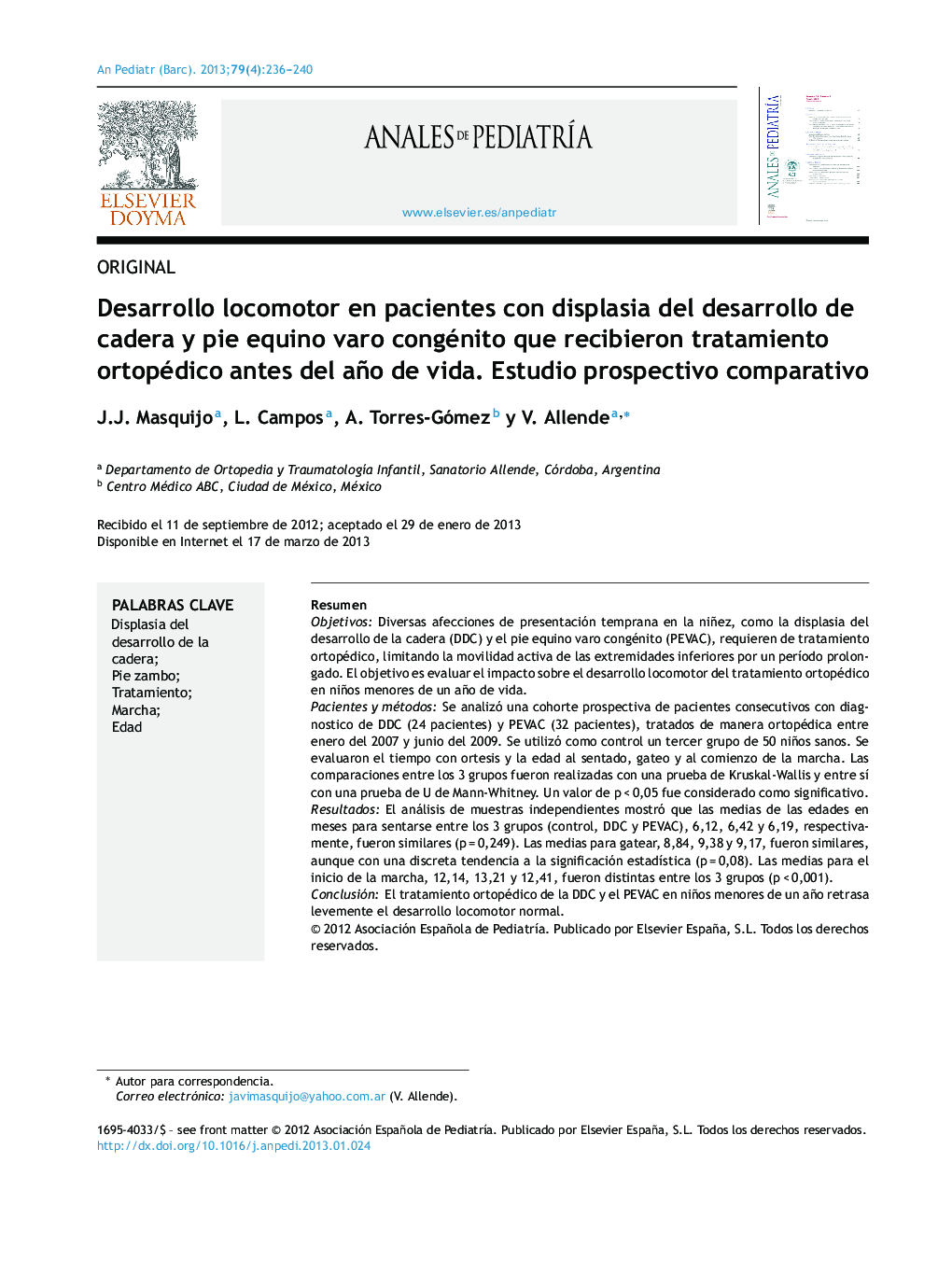| Article ID | Journal | Published Year | Pages | File Type |
|---|---|---|---|---|
| 4141669 | Anales de Pediatría | 2013 | 5 Pages |
ResumenObjetivosDiversas afecciones de presentación temprana en la niñez, como la displasia del desarrollo de la cadera (DDC) y el pie equino varo congénito (PEVAC), requieren de tratamiento ortopédico, limitando la movilidad activa de las extremidades inferiores por un período prolongado. El objetivo es evaluar el impacto sobre el desarrollo locomotor del tratamiento ortopédico en niños menores de un año de vida.Pacientes y métodosSe analizó una cohorte prospectiva de pacientes consecutivos con diagnostico de DDC (24 pacientes) y PEVAC (32 pacientes), tratados de manera ortopédica entre enero del 2007 y junio del 2009. Se utilizó como control un tercer grupo de 50 niños sanos. Se evaluaron el tiempo con ortesis y la edad al sentado, gateo y al comienzo de la marcha. Las comparaciones entre los 3 grupos fueron realizadas con una prueba de Kruskal-Wallis y entre sí con una prueba de U de Mann-Whitney. Un valor de p < 0,05 fue considerado como significativo.ResultadosEl análisis de muestras independientes mostró que las medias de las edades en meses para sentarse entre los 3 grupos (control, DDC y PEVAC), 6,12, 6,42 y 6,19, respectivamente, fueron similares (p = 0,249). Las medias para gatear, 8,84, 9,38 y 9,17, fueron similares, aunque con una discreta tendencia a la significación estadística (p = 0,08). Las medias para el inicio de la marcha, 12,14, 13,21 y 12,41, fueron distintas entre los 3 grupos (p < 0,001).ConclusiónEl tratamiento ortopédico de la DDC y el PEVAC en niños menores de un año retrasa levemente el desarrollo locomotor normal.
ObjectivesSeveral disorders of early childhood, such as developmental dysplasia of the hip (DDH) and clubfoot, requires orthopedic treatment that limits active mobility of the lower extremities for a period of time. The aim of our study was to evaluate the impact on locomotor development of the orthopedic treatment in infants less than one year-old.Patients and methodsThe study included a prospective cohort of consecutive patients diagnosed with developmental dysplasia of the hip (Group A, 24 patients), and clubfoot (Group B, 32 patients) treated from January 2007 to June 2009. A third group (Group C) of 50 healthy children was used as control. The variables evaluated were: months with a brace, age to sit without support, age at the start of crawling, and age at the beginning of walking. The results obtained were analyzed. Comparisons between the three groups were performed using the Kruskal-Wallis test and Mann-Whitney test. We chose a value of P<.05 as level of statistical significance.ResultsThe analysis of independent samples showed that the mean age at which the patients began to sit were similar: 6.12, 6.42 and 6.19 months, respectively (P=.249). The mean age for crawling was similar, although with a slight trend toward statistical significance: 8.84, 9.38 and 9.17 months, respectively (P=.08). The age at which they started walking was different between the three groups: 12.14, 13.21 and 12.41 months, respectively (P<.001).ConclusionOrthopedic treatment of DDH and clubfoot in children less than one year-old slightly slows down the course of normal locomotor development.
